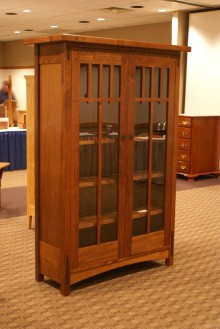Who am I to judge?
Article - March 1, 2008
A few weeks ago I was given the opportunity to judge a woodworking show. Specifically, the Excellence in Woodworking show in Mesa, AZ. It was an honor and a privilege to be a part of the event and I’d like to thank the AZ Association of Fine Woodworkers for including me. The variety of projects on display were incredible. From toys that looked like scale models to a wall-hanging jungle-themed intarsia, it was a sight to see. I’ve included a few pictures with this article for your enjoyment.
 I scrutinized each and every piece and tried to decide what might make one thing “better” than another. Not an easy job! So my strategy was to begin by looking at all the positive attributes each creation had to offer. In many cases, there was a clear winner. But sometimes, looking at the positive will only get you so far. Should a “tie” result, you have no choice but to really start to hammer down on the negative aspects. As I began to point out errors in construction, gaps in joints, and the flaws in the finish, I realized there was a valuable lesson in this process. By looking at someone else’s work and identifying every little flaw (something I rarely have the opportunity to do), I started to realize that being able to identify them means I should never allow the same errors to occur in my own work.
I scrutinized each and every piece and tried to decide what might make one thing “better” than another. Not an easy job! So my strategy was to begin by looking at all the positive attributes each creation had to offer. In many cases, there was a clear winner. But sometimes, looking at the positive will only get you so far. Should a “tie” result, you have no choice but to really start to hammer down on the negative aspects. As I began to point out errors in construction, gaps in joints, and the flaws in the finish, I realized there was a valuable lesson in this process. By looking at someone else’s work and identifying every little flaw (something I rarely have the opportunity to do), I started to realize that being able to identify them means I should never allow the same errors to occur in my own work.
 Now I’m not talking about errors that result from a lack of skill. I’m referring to the things I do simply out of laziness or impatience. I thought to myself, “Why is it so glaringly obvious in someone else’s work but so hard to see in my own??” The more I thought about it, the more I realized that this might just be part of the human condition. It’s not all that different from a person who is quick to notice dirt on the floor of someone else’s home, but remains blissfully unaware of the dog hair gathering in the corners of his own home, hypothetically speaking of course. ;) But the key here is recognizing that this type of thing happens. And admitting it is the first step in preventing it in the future. Taking the phrase, “good enough” out of my vocabulary is a good start. We all have our own personal standards for our woodwork, but I bet we could all afford to raise them slightly.
Now I’m not talking about errors that result from a lack of skill. I’m referring to the things I do simply out of laziness or impatience. I thought to myself, “Why is it so glaringly obvious in someone else’s work but so hard to see in my own??” The more I thought about it, the more I realized that this might just be part of the human condition. It’s not all that different from a person who is quick to notice dirt on the floor of someone else’s home, but remains blissfully unaware of the dog hair gathering in the corners of his own home, hypothetically speaking of course. ;) But the key here is recognizing that this type of thing happens. And admitting it is the first step in preventing it in the future. Taking the phrase, “good enough” out of my vocabulary is a good start. We all have our own personal standards for our woodwork, but I bet we could all afford to raise them slightly.






